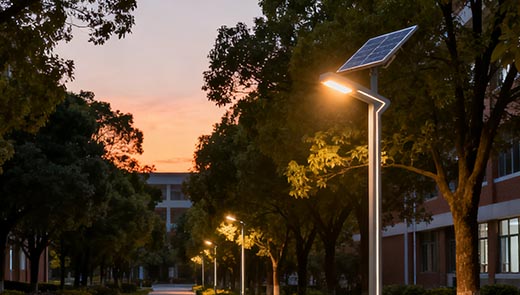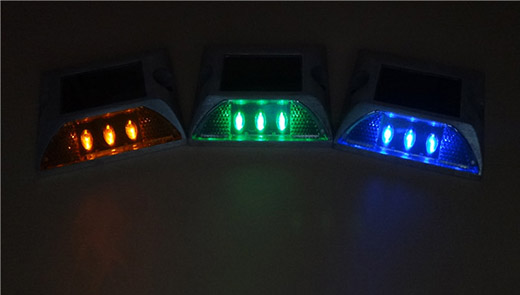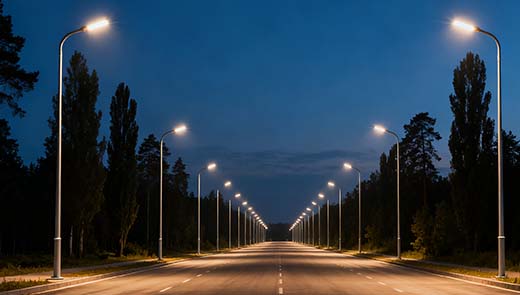All-in-One Solar Street Lights: Are They Worth It
In the global wave of green energy transformation, solar street lights, as a typical example of clean energy applications, are gradually changing the traditional lighting landscape. Among them, integrated solar street lights, with their unique design and functionality, have become a popular choice for many projects. However, investors and users can't help but ask: are integrated solar street lights worth investing in? Let's take a closer look.
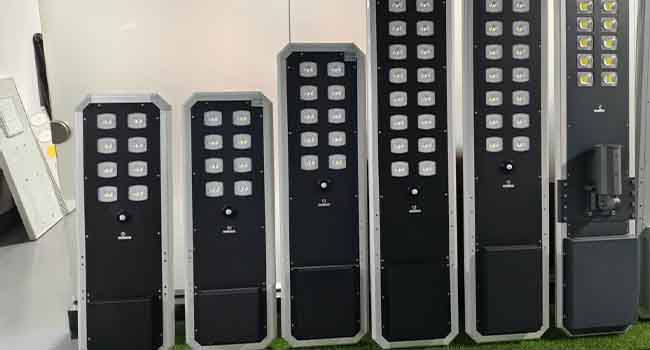
What is An All-In-One Solar Street Light?
Unlike split-type solar street lights, where the lamp, solar panel, and battery components must be separately mounted on the lamp post, some older models even bury the battery underground. With the advancement of lithium-ion battery technology, modern batteries such as lithium-ion batteries and lithium iron phosphate batteries are now compact in size yet offer higher capacity. This has enabled the integration of solar panels and battery storage, giving rise to integrated solar street lights. These lights integrate all components into a single structure mounted at the top of the lamp post, featuring a range of advanced functions, representing an innovative achievement in modern lighting technology.
Inside the Integrated All-In-One Solar Street Light
Solar Panel
The high-efficiency monocrystalline panels mounted at the top of the integrated solar street light utilize advanced monocrystalline silicon cutting and purification processes, achieving a photovoltaic conversion efficiency of 22%–24%, far exceeding that of ordinary polycrystalline panels. These panels employ special surface treatment technology to reduce light reflection, enabling them to effectively capture solar energy even in low-light conditions such as cloudy or hazy weather. In high-latitude regions or cities with average sunlight resources, it can still operate stably, efficiently converting solar energy into electricity to continuously power the street light's nighttime illumination, effectively addressing the issue of unstable power supply in traditional street lights during extreme weather conditions.
Batteries
The system uses lithium iron phosphate batteries to store the energy converted by the solar panels. These batteries are renowned for their long lifespan and high safety, featuring high energy density to achieve powerful energy storage in a compact size. Their excellent deep discharge capability ensures street lights remain bright all night even during consecutive days of cloudy weather, while their long lifespan reduces the hassle of frequent replacements.
Controller
The controller serves as the “brain” of the integrated solar street light system, overseeing the operation of every component within the system. It precisely manages the charging and discharging processes to extend battery lifespan and can intelligently control the street light's on/off status and brightness adjustment based on pre-set programs or environmental changes, ensuring the system operates efficiently and durably.
Aluminum Frame
The sturdy aluminum frame encases the internal core components of the street light, ensuring structural stability while maintaining aesthetic appeal. It effectively withstands various harsh weather conditions, protecting internal components, and its sleek design seamlessly integrates with urban and rural landscapes.
PCB and LED Chip
The printed circuit board (PCB) is made of high-thermal-conductivity metal-based material, combined with a multi-layer wiring design, effectively enhancing circuit stability and heat dissipation performance. The LED chips are selected from well-known brands with high luminous efficiency, achieving a luminous efficiency of 150–200 lm/W, which is 60%–70% more energy-efficient than traditional sodium lamps. Through advanced packaging technology, the LED chips achieve a color rendering index (CRI) of over 80, accurately reproducing object colors and enhancing nighttime visual effects. Working in tandem, they ensure high-brightness lighting while enabling precise light control to prevent light waste. Additionally, the LED chips have a lifespan of 50,000–100,000 hours, significantly reducing the frequency of fixture replacements.
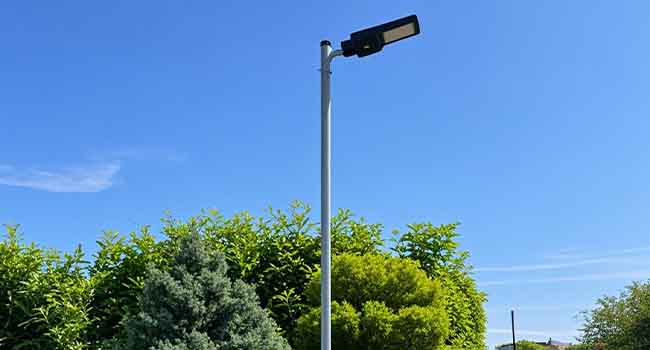
Optical Lenses
Optical lenses are specifically designed for street lighting and work in conjunction with LED lights to optimize light distribution, creating a wide and uniform lighting area. This enhances visibility, ensuring the safety of pedestrians and vehicles, while also avoiding glare and light pollution.
PIR Motion Sensor
The integration of a passive infrared (PIR) motion sensor grants the street light intelligent sensing capabilities. When the sensor detects nearby movement, the street light brightness automatically increases to 100%; after 20 seconds of inactivity in the area, it intelligently adjusts back to 30% brightness, achieving dual improvements in energy efficiency and safety.
Working Principle of Integrated Solar Street Light
Daytime Charging
During the day, the integrated solar street light utilizes advanced photovoltaic technology in its solar panels to efficiently convert sunlight into electrical energy, which is then stored in high-capacity lithium iron phosphate batteries, ensuring sufficient power for nighttime illumination.
Dusk Activation
As dusk approaches and ambient light intensity drops below a specific threshold (typically 10–20 lux), the solar panels' power generation capacity significantly decreases. The high-precision light sensor built into the smart controller detects this change in real time. To ensure the system's sustainable operation, the controller swiftly activates the street light's lighting mode. The street light turns on at 30% brightness (Eco mode), which provides sufficient lighting for pedestrians while significantly reducing energy consumption. Compared to full-brightness lighting, Eco mode reduces battery energy consumption by approximately 60–70%, effectively extending battery lifespan. This mode is particularly suitable for community roads and rural paths with low nighttime foot and vehicle traffic.
Motion-Detected Illumination
The PIR motion sensor utilizes the pyroelectric effect to detect moving targets by sensing infrared radiation (8–14μm) emitted by humans or vehicles. When pedestrians or vehicles enter the sensor's detection range of 110°–130° and within a distance of 12–15 meters, the sensor instantly triggers a signal, causing the street light brightness to surge from 30% to 100% within 0.3 seconds, providing adequate illumination for the target area. After the target leaves the detection area, the street light automatically returns to 30% brightness after 20 seconds. Based on real-world testing, this feature reduces overall energy consumption by 30%–50% while significantly enhancing nighttime road safety and reducing the likelihood of traffic accidents and criminal incidents.
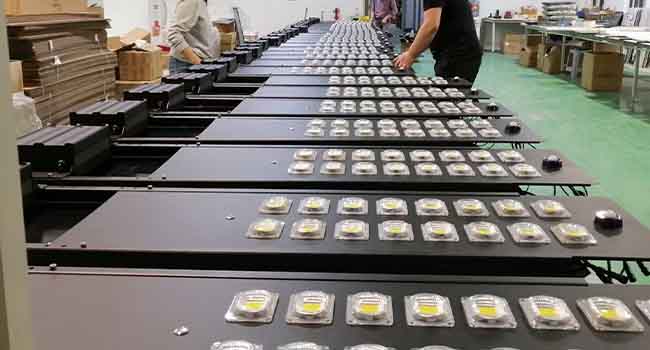
Customizable Brightness
Users can adjust the brightness of the street lights between 10% and 100% within scheduled lighting periods via a remote management platform or local control interface, tailored to specific environmental needs. In park pathways, brightness can be adjusted to 20% during late-night hours to create a soft and serene atmosphere; on busy main roads, 100% brightness is maintained during peak hours to ensure driving safety. This highly flexible brightness adjustment feature, combined with the smart controller's automatic dimming algorithm, ensures optimal lighting performance while achieving precise energy management. Compared to fixed-brightness lighting, the overall energy-saving effect can exceed 40%.
What are The Special Features of All-In-One Solar Street Lights
Structural Design
All-in-one solar street lights integrate solar panels, lighting fixtures, batteries, and control systems into a single module, simplifying the appearance and reducing exposed wiring. In contrast, semi-integrated solar street lights only integrate some components, with batteries and solar panels requiring additional connections, resulting in more installation steps. The all-in-one design makes installation and maintenance more convenient. Here is a comparison of the two:
|
Type |
Component Integration |
Installation Complexity |
|
Integrated Solar Street Light |
All components integrated into a single module |
Low, no extra wiring or brackets required |
|
Semi-Integrated Solar Street Light |
Partial integration; battery and panel separate |
High, requires connecting components, brackets, and cables |
Ease of Installation
The integrated design greatly simplifies the installation process, eliminating the need for additional wiring and bracket installation. Compared to traditional street lights, installation time can be reduced by more than 60%. It is particularly suitable for remote mountainous areas without grid coverage, rural roads with harsh construction conditions, and projects with strict construction time requirements. Take a mountain village as an example: using integrated solar street lights, the entire village's road lighting was installed in just a few days, quickly resolving residents' nighttime travel challenges.
Aesthetics and Maintenance
The integrated street light's compact, streamlined design, free of exposed cables, seamlessly integrates into various environments such as parks, scenic areas, and commercial streets, enhancing the visual appeal of the space with a clean, aesthetic appearance. In terms of maintenance, integrated street lights offer significant advantages. In the event of a malfunction, the entire module can be replaced directly, with repair time typically not exceeding 1 hour; in contrast, semi-integrated street lights, due to their dispersed components, require longer fault diagnosis and repair times, with an average repair time of 3–4 hours. Integrated street lights effectively reduce maintenance costs and labor input while improving maintenance efficiency.
Limitations of Integrated Solar Street Lights
Heat Dissipation Issues
In the design of integrated solar street lights, the battery, circuitry, and lighting components are closely adjacent, severely limiting heat dissipation. When the street light operates for extended periods, the heat generated by lighting, battery charging/discharging, and circuit operation accumulates, making it difficult to quickly and effectively dissipate the heat into the surrounding environment. According to professional test data, in high-temperature summer environments, the internal local temperature of integrated street lights may be 20–30°C higher than the external environment temperature.
Prolonged exposure to high temperatures can impair the chemical activity of batteries, leading to accelerated capacity degradation and a potential reduction in battery lifespan of 30–40%. Circuit components may also experience performance instability due to high temperatures, increasing the likelihood of failures and thereby reducing the overall performance and lifespan of the street light. This, in turn, can lead to increased maintenance and replacement costs in the long term.

Configuration Limitations
Integrated solar street lights are constrained by their component integration design, offering limited flexibility in power and battery capacity configurations. Their internal components are carefully designed and integrated into a relatively fixed system, making it difficult for users to customize power and battery capacity settings. In contrast, semi-integrated street lights feature independent components, allowing users to freely select different specifications of solar panels, batteries, and other components based on actual needs.
For example, in highway lighting projects, due to the long road length and high nighttime traffic volume, high-power, large-capacity energy storage street lights are required to ensure continuous and high-intensity lighting throughout the night. The standard configuration of integrated solar street lights cannot meet this special requirement, so semi-integrated street lights must be selected. By customizing high-power solar panels and large-capacity batteries, the desired lighting effect can be achieved.
Application Scenarios for Integrated Solar Street Lights
Integrated solar street lights are suitable for various scenarios due to their unique features. In small communities, rural roads, and other areas with low power requirements, their cost-effectiveness and convenient installation advantages are evident; in remote areas without grid access or where construction is inconvenient, integrated street lights can quickly resolve lighting issues; in urban landscape roads with high aesthetic requirements, their sleek design can seamlessly blend with the environment.
Whether integrated solar street lights are worth investing in depends on the specific application scenario: their advantages lie in their ease of installation and maintenance, as well as their cost-effectiveness, making them suitable for standardized lighting scenarios such as small communities and rural roads; however, their limitations in heat dissipation and power configuration mean they perform inadequately in high-temperature or high-power demand scenarios. It is recommended to flexibly select based on project budget, installation convenience, and lighting requirements. With ongoing technological advancements, they still hold potential in the field of green lighting.

